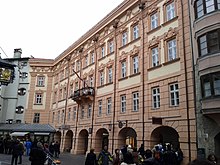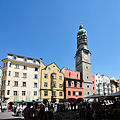Herzog-Friedrich-Strasse
| Herzog-Friedrich-Strasse | |
|---|---|
| Street in Innsbruck | |
| Herzog-Friedrich-Strasse with a view of the Golden Roof | |
| Basic data | |
| place | innsbruck |
| district | Downtown |
| Created | 12th Century |
| Hist. Names | Chramgasse, Hauptgasse, Oberer / Unterer Stadtplatz |
| Name received | 1873 |
| Connecting roads | Innbrücke, Maria-Theresien-Strasse |
| Cross streets | Herzog-Otto-Ufer, Pfarrgasse, Hofgasse, Riesengasse, Stiftgasse, Kiebachgasse, Marktgraben, Burggraben |
| Buildings | Ottoburg , Goldenes Dachl , City Tower , Helblinghaus |
| use | |
| User groups | pedestrian |
| Technical specifications | |
| Street length | 300 m |
The Herzog-Friedrich-Strasse is the main road through Innsbruck's Old Town . It is named after Duke Friedrich IV "with the empty pocket".
course
The Herzog-Friedrich-Straße begins at the Innbrücke and runs as an extension to the east into the old town. At the Golden Roof it bends almost at a right angle and continues south, where it merges into Maria-Theresien-Straße at the crossing of Marktgraben and Burggraben (the former city moat) . In the central area around the Golden Roof and the city tower it is expanded like a square. This area was formerly known as the town square, but does not officially bear that name today. At the Golden Roof, Hofgasse leads west to the Hofburg and Pfarrgasse leads north to the cathedral . Further cross streets are the Kiebachgasse, the Seilergasse, the Riesengasse and the Stiftsgasse.
history
Like the floor plan of the entire old town, Herzog-Friedrich-Straße goes back to the time the city was founded in the 12th century. At the latest since the rule of the Counts of Tyrol (from 1248) it has taken its current form. The end in the east was the Inntor, which was broken off in 1790, and in the south, the suburban gate, which was broken off in 1765.
The street got its current appearance at the beginning of modern times. After several city fires, the houses, some of which were made of wood, were built entirely of stone from around 1500 in the Inn-Salzach construction method . With their style, which lies somewhere between Gothic and Renaissance , the Türing family of architects, appointed by Duke Siegmund to Innsbruck, shaped the cityscape. To expand the living space, the first floor was moved into the street space, creating open arches underneath, the characteristic arbors , which were often decorated with frescoes.
In 1972 Herzog-Friedrich-Strasse and the entire old town became a pedestrian zone.
Surname
The street was originally called Chramgasse or Unter den Chramen after the front of the shops that the merchants operated on the ground floor of their houses, but it was also known as Gemeine Straße or around 1840 by Johann Jakob Staffler as Hauptgasse , the section leading towards the Innbrücke also called Inntorgasse . The extension in front of the Golden Roof was called Oberer Stadtplatz , the area in front of Ottoburg was called Unterer Stadtplatz . In 1873 the citizens' committee (municipal council) decided to rename it to Herzog-Friedrich-Straße . The supplementary motion to name the western part in memory of Andreas Hofer and his address from a window of the Golden Eagle Sandwirtsstrasse was rejected.
The Tyrolean Prince Frederick IV is closely associated with the city. In 1420 he had the royal residence relocated from Meran to Innsbruck and two town houses on the town square were converted into the New Court. In popular tradition, he is also considered the builder of the Golden Roof, which Maximilian I only had it built in 1494/96 .
use
The Herzog-Friedrich-Straße was the most important Innsbrucker street until modern times, through which all traffic from the south ( Wilten , Brenner ) to the Innbrücke (until the end of the 16th century the only Inn crossing in the Innsbruck area) and further into the upper and Lower Inn Valley flowed.
In particular, the area in front of the Golden Roof was often used for public performances and rallies. During the time of Emperor Maximilian, tournaments and performances took place on the square , which he observed from the Golden Roof. In 1536 Jakob Hutter was burned at the stake here as a "heretic". At the Olympic Winter Games 1964 and 1976 and the Olympic Youth Winter Games 2012 , the award ceremonies took place on the square.
Since 1460, a weekly market has been held on Mondays under the arbors of Herzog-Friedrich-Strasse, which was moved to Innrain in 1679 . From 1657 to 1861, when it was moved to Maria-Theresien-Straße, every year on 5th / 6th December the Nikolausmarkt takes place on the town square. The Christmas market has existed here since 1965, and the Christmas tree has been set up in front of the Golden Roof since the 1930s.
Significant buildings
- Ottoburg (No. 1): The four-storey late Gothic residential tower with a corner core on the Inn Bridge was built in its current form in 1494/95.
- Old government building ( "Claudiana" , No. 3): In 1569 Archduke Ferdinand II had two buildings converted into official buildings for the Upper Austrian government. After it was destroyed in the earthquake of 1689, it was rebuilt in baroque form by Johann Martin Gumpp the Elder .
- Hotel Goldener Adler (No. 6): One of the oldest inns in Innsbruck was founded in 1390 and rebuilt after the fire in 1450. Numerous important personalities have stayed here.
- Helblinghaus (No. 10): The originally Gothic town house from the 15th century was given a lush Rococo stucco facade around 1725.
- New courtyard (No. 15): Friedrich IV had his new residence built from two town houses in 1420, and in 1494/96 the later Emperor Maximilian I had an existing bay window converted into the Golden Roof .
- Katzunghaus (No. 16): The residential and commercial building, first mentioned in 1450, has eye-catching sandstone reliefs in the bay parapets with tournament and minstrel scenes from around 1530.
- Old town hall with town tower (No. 21): In 1358 a town house on the town square was converted into town hall, which was expanded several times. The 56 m high city tower was added around 1450.
- Trautsonhaus (No. 22): The house built by Georg Türing in 1541 is an important example of the transition from Gothic to Renaissance. The baroque marble fountain in front of the house is the only city fountain that has been preserved in its original location.
- Old country house (No. 29): The building, documented as an inn in 1572, was bought by the Tyrolean estates in 1613 and served as the first permanent Tyrolean country house until the new building in Neustadt (Maria-Theresien-Straße) was built in 1666 .
Views
literature
- Josefine Justic: Innsbruck street names. Where do they come from and what they mean . Tyrolia-Verlag, Innsbruck 2012, ISBN 978-3-7022-3213-9 , p. 22-23 .
- Otto Stolz : About the construction of Innsbruck's town houses in the Middle Ages. In: Publications of the Tiroler Landesmuseum Ferdinandeum, 20–25 (1940/45), pp. 17–26 ( PDF; 4.3 MB )
Web links
Individual evidence
- ↑ Traffic regulations for the pedestrian zone in the old town. In: Official Journal of the State Capital Innsbruck, number 5, May 1972, p. 7 ( digitized version )
- ↑ Verena Asen: History of the Innsbruck Christmas Market. In: Innsbruck informs, December 1999, p. 18 ( digitized version )
- ↑ Wiesauer: Ottoburg. In: Tyrolean art register . Retrieved July 8, 2015 .
- ^ Franz-Heinz Hye : The old government building. In: Official Journal of the State Capital Innsbruck, No. 12, 1969, p. 14 ( digitized version )
- ^ Franz-Heinz Hye: From Neuenhof to the Golden Roof - the beginnings of the Innsbruck residence. In: Innsbruck informed, June 1996, p. 14 ( digitized version )
- ↑ a b Reinhard Rampold (Ed.): Kunstführer Tirol. The 400 most important art treasures in North and East Tyrol. Tyrolia-Verlag, Innsbruck 2014, p. 14
- ↑ Wiesauer: Laufbrunnen, fountain in front of the Trautsonhaus. In: Tyrolean art register . Retrieved July 8, 2015 .
- ^ Wiesauer: Commercial and residential buildings, old country house, Freysinghaus, Frankhaus. In: Tyrolean art register . Retrieved July 8, 2015 .
Coordinates: 47 ° 16 '6 " N , 11 ° 23' 35.7" E










